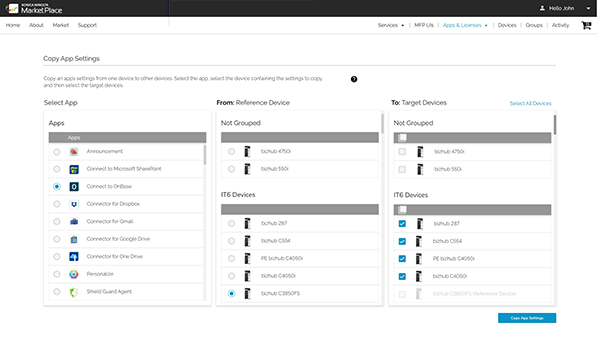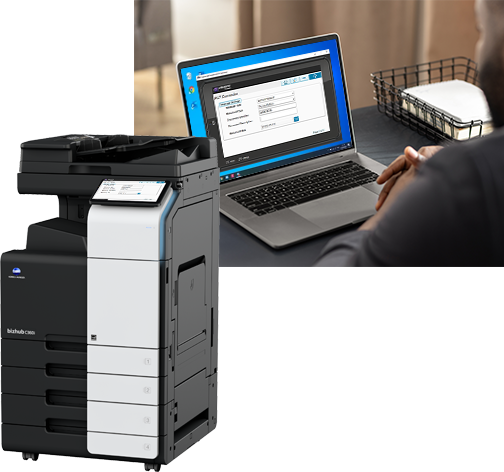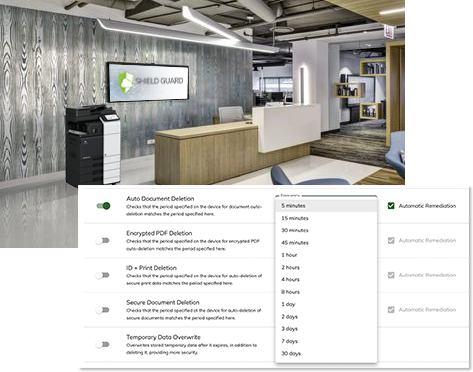
Rethink Scan to Cloud Fax With Dispatcher Phoenix ScanTrip!
Dispatcher® Paragon+ now offers a cloud fax extension in addition to the core function of centralized print management — allowing you to reduce print, copy, and fax costs. Productivity and document security are improved through automated scan workflows and secure pull printing.
The Cloud Fax extension can save you even more, because it eliminates the need for expensive MFP fax kits and analog/VoIP telephone lines. The Cloud Fax extension is embedded into the MFP, making it ideal for simple fax workflows. For your convenience, incoming faxes can be received as an email, stored to a network directory, or automatically put into a secure queue to be released at any time. Outgoing paper documents may be faxed from the MFP or electronic documents may be faxed from the web portal.
To better utilize the fax capabilities of Dispatcher Paragon+, Konica Minolta introduced the Cloud Fax Connector. This highly-streamlined node allows your scanned documents to be distributed from Dispatcher Phoenix as digital faxes using Dispatcher Paragon's Cloud Fax service. This node is available for free to any Dispatcher Phoenix, Dispatcher Phoenix ScanTrip, or Dispatcher Paragon+ customers and can be installed as needed to support fax workflows.
Empower your users with scan-to-Cloud Fax capabilities, including:
- 1-touch fax buttons to a pre-configured list of contacts.
- Customizable fax settings at scan time including recipient name, fax number, etc.
- Seamless connectivity to Paragon's Cloud Fax capabilities.
- Monitor scan-to-fax operations in the Paragon Cloud Fax portal.
To discover how Paragon's Cloud Fax capabilities can streamline your scan workflows, download the sample workflow today.

Cloud-based App Management - Install and Edit MarketPlace Apps Remotely
We're thrilled to announce the latest addition to Marketplace's Device and App Management tools - The Mass App Configuration Tool! The Mass App Configuration feature enables you to copy an app's configuration settings to any or all of your devices on which the app is installed - right from your desktop - a huge time-saver!
The intuitive design of the new Copy App Settings page directs users to select (1) the app whose settings they want to copy, (2) the device on which the app currently resides, and (3) the devices to which the app settings will be copied.

To facilitate this enhancement, the Apps & Licenses option on the MarketPlace menu bar is now a drop-down menu providing access to the following options:
- Apps & Licenses page - This page is now product-specific, displaying only the products associated with your selection on the Apps & Licenses menu (for example, Apps or MFP UI Licenses).
- Copy App Settings page - Accesses the Mass App Configuration feature.
- Operations - This page, formerly accessible only via the Devices page, is now also available via the Apps & Licenses menu. When accessed from this menu, the page lists operations for all of the user's MarketPlace devices. A new Filters panel has been added, enabling users to restrict the list of operations to selected criteria, for example, devices or operations.
Visit the Copy App Settings page now to experience how easily you can maintain the configuration settings of your MarketPlace apps.

Dispatcher Phoenix Simulators - The Ultimate Sales Tool!
Show your customers what Dispatcher Phoenix looks like on an MFP - without ever needing to install the application or connect to a physical MFP! Dispatcher Phoenix offers 3 different simulators to allow you to showcase the solution's scan workflow capabilities anywhere and anytime.
1. Online Simulator
- Convenient web-based access.
- Use your iPad, Android tablet, or PC with Web Browser to easily demonstrate Dispatcher Phoenix workflows running on any MFP.
- No in-depth knowledge of the product is required.

- Pre-configured workflows to highlight some powerful features.
2. Standalone Simulator
- Installable, stand-alone application.
- No internet connection required.
- No in-depth knowledge of the product is required.
- Pre-configured workflows to highlight some powerful features.
3. Integrated Simulator
- Accessed through the Dispatcher Phoenix client application.
- Demo any advanced scan sample workflow.
- Create customer scan workflows to meet specific requirements.
- Submit files directly into Dispatcher Phoenix to test customer scan workflows.
Each of the simulators has slightly different capabilities and purposes. Generally speaking, you use the Integrated MFP Simulator to access simulated versions of live Dispatcher Phoenix workflows. This version requires an active connection to Dispatcher Phoenix. You use the Online and Stand-alone simulators to access “canned” workflows for demonstration purposes. These versions do not require a connection to Dispatcher Phoenix.
Once you start the Online or Standalone Simulator, you are presented with a variety of workflows that highlight Dispatcher Phoenix's most powerful features on bizhub, i-Series, and production print devices. Since all workflows are pre-configured and ready for you to use, you can showcase Dispatcher Phoenix's integration on the MFP, including folder browsing, document indexing, editing Bates stamps, and connecting to OnBase®, Hyland® Software's enterprise content management system.
Dispatcher Phoenix's integrated simulator will support any scan workflow from the comprehensive library of sample workflows.
For more information on Dispatcher Phoenix's Simulators, visit the SEC Website.

Shield Guard - Best Practices for Creating Security Policies
The following are a few best practices as recommended by Shield Guard professionals. Each of the practices will help you configure the policies you create to protect your devices, and help you determine how many different policies you need to protect all your different devices.
Know your device fleet!

- Where is each device located? In a public area? A secure office space? The CEO's office? The physical location of the device will affect the protections you enable for a device.
- Who uses the device? The needs of those users, as well as the types of data they need to access, help to determine the protections you enable for a device. For example, accounts receivable personnel may need to enable protections for document transmission protocols, while a device used by warehouse personnel may not have access to transmission protocols so those settings can be disabled on that device.
- How often is the device used? A heavily-trafficked device will likely require certain projections, for example that one or more of the data-deletion settings be enabled.
Know your device's security settings.
- Consult your device's documentation to learn about the security settings on each device. The more you know about your options, the easier it will be to create and modify your Shield Guard policies.
Employ an intelligent naming scheme for your policies.
- If you have a large device fleet, an intuitive naming scheme for your policies is critical. Each name should indicate the policy's use or purpose, and should be structured so that when sorted by name, like devices appear together in the list.
Use the Policy Cloning feature.
- Creating a new policy based on a cloned policy can be a big time-saver.
To learn more about how you can protect and secure your business with Shield Guard, CLICK HERE!







